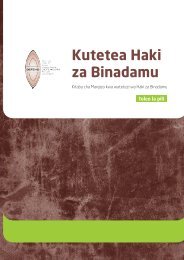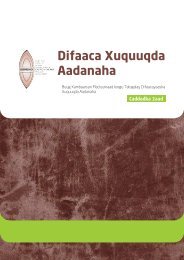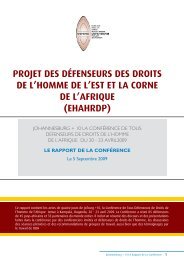Table of Contents - East and Horn of Africa Human Rights ...
Table of Contents - East and Horn of Africa Human Rights ...
Table of Contents - East and Horn of Africa Human Rights ...
Create successful ePaper yourself
Turn your PDF publications into a flip-book with our unique Google optimized e-Paper software.
Regional Workshop on Women <strong>and</strong> Minority <strong>Human</strong> <strong>Rights</strong> Defenders<br />
Participants learnt that the responsibility for implementing the mainstreaming strategy is<br />
system-wide, <strong>and</strong> rests at the highest levels within organizations. The presenter told<br />
participants that gender mainstreaming follows specific steps, including:<br />
� The initial diagnosis <strong>of</strong> issues <strong>and</strong> problems across all areas / activities <strong>of</strong> an<br />
organization;<br />
� The adoption <strong>of</strong> gender mainstreaming policies;<br />
� The use <strong>of</strong> tools for gender mainstreaming, such as gender analysis, the use <strong>of</strong> data<br />
disaggregated by sex <strong>and</strong> age, sector-specific gender surveys, gender sensitive studies as<br />
well as guidelines <strong>and</strong> checklists for programming;<br />
� The establishment <strong>of</strong> instruments <strong>and</strong> mechanisms for monitoring <strong>and</strong> evaluation, such<br />
as gender- impact analysis methodologies;<br />
� Allocation <strong>of</strong> adequate resources for mainstreaming, including additional financial <strong>and</strong><br />
human resources;<br />
� The creation <strong>of</strong> accountability mechanisms such as monitoring for gender<br />
mainstreaming.<br />
It was also stressed that gender mainstreaming is a commitment comprising <strong>of</strong> a wide range <strong>of</strong><br />
actions that require an institution to pay attention to the unequal relationships <strong>of</strong> power within<br />
all structures <strong>and</strong> organizational frameworks. It requires the making <strong>of</strong> some hard decisions in<br />
order to ensure that human rights defenders are availed with protection mechanisms that come<br />
with the vulnerabilities <strong>of</strong> their work. Gender mainstreaming should in particular tilt to fit the<br />
work <strong>of</strong> human rights defenders. It should address aspects such as non documentation <strong>of</strong><br />
violations <strong>and</strong> abuses against defenders in order for them to dem<strong>and</strong> accountability for, <strong>and</strong><br />
support each other. Further, it should address features such stress, trauma, burn-out, loss <strong>of</strong> self<br />
esteem <strong>and</strong> non recognition <strong>of</strong> human rights defenders. Participants were called upon to get<br />
more skills on this subject matter, to embed gender in organizational roles <strong>and</strong> processes <strong>and</strong> to<br />
build the capacity <strong>of</strong> others in their organizations.<br />
The participants ended the day with a documentary featuring stories <strong>of</strong> victims <strong>of</strong> gender<br />
violence titled “Four Stories <strong>of</strong> Women Survivors <strong>of</strong> Domestic Violence.” Two key messages<br />
arose from the documentary;<br />
15 | P a g e<br />
“Men must st<strong>and</strong> up <strong>and</strong><br />
be equal partners against<br />
gender based violence. “<br />
“ Gender Based Violence<br />
hurts the whole society,<br />
<strong>and</strong> not only the receiving<br />
victim.”








